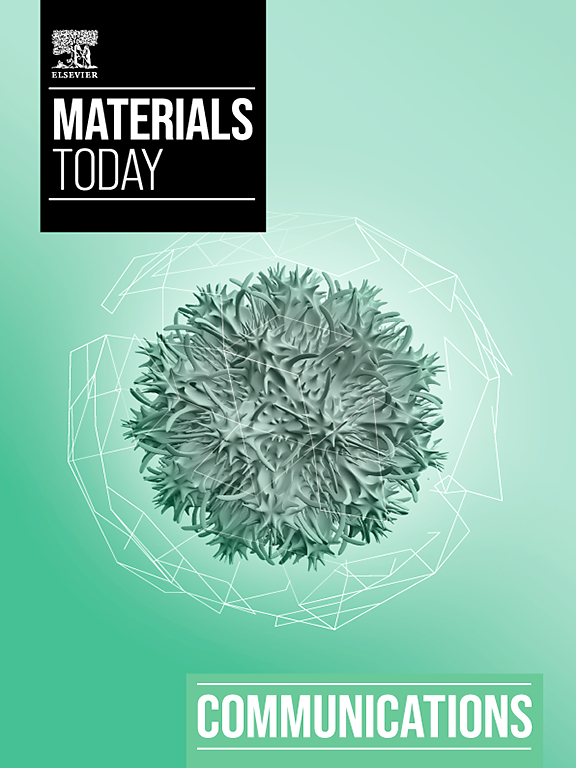Characterization of Nano-kaolin and its enhancement of the mechanical and corrosion resistance of epoxy coatings
IF 4.5
3区 材料科学
Q2 MATERIALS SCIENCE, MULTIDISCIPLINARY
引用次数: 0
Abstract
This study compares the effects of varying concentrations of nano-kaolin and titanium dioxide on the mechanical and corrosion resistance of epoxy coatings. Characterization techniques such as TEM, XRD, Raman, FTIR, XPS, and AFM revealed surface features of nano-kaolin: the particle size reached the nanoscale, the XRD diffraction peak at 2θ = 25.3° disappeared, Raman peaks broadened with decreased intensity, and a blue shift occurred in the FTIR spectra for various functional groups. Compared to pure epoxy coatings, the composite epoxy coating with 10 wt% nano-kaolin showed an 83.87 % increase in adhesion, an 81.82 % improvement in impact resistance, and a 61.42 % reduction in friction coefficient; while a 20 wt% titanium dioxide composite coating showed a 74.19 % increase in adhesion, a 75.76 % improvement in impact resistance, and a 46.9 % reduction in friction coefficient. Electrochemical tests indicated that a composite coating with 10 wt% nano-kaolin, after soaking in 3.5 wt% NaCl solution for 960 hours, achieved a corrosion efficiency of 98.87 % and an impedance modulus of 10Ω.cm which was three orders of magnitude higher than that of pure epoxy resin, increasing corrosion resistance by 57.14 %; whereas a 20 wt% titanium dioxide composite coating reached a corrosion efficiency of 89.29 % and an impedance modulus of 10Ω.cm after the same conditions, increasing corrosion resistance by 17.86 % compared to the pure epoxy resin. The composite coating with 10 wt% nano-kaolin exhibited superior mechanical and corrosion resistance, outperforming the 20 wt% titanium dioxide coating. Mechanical and corrosion mechanisms suggest that the uniformly dispersed nano-kaolin inhibits interactions between epoxy resin molecules and carries the external load, thereby enhancing intermolecular cohesion. Improved adhesion and impact resistance indirectly extend the coating's lifespan by prolonging the path of corrosion media through the coating to the substrate. The novel coating modification method proposed in this study effectively replaces titanium dioxide and enhances the coating's mechanical and corrosion resistance, offering a new solution for corrosion prevention in metal materials.纳米高岭土的表征及其对环氧涂层机械性能和耐腐蚀性能的增强作用
本研究比较了不同浓度的纳米高岭土和二氧化钛对环氧涂层的机械性能和耐腐蚀性能的影响。TEM、XRD、拉曼、傅立叶变换红外光谱、XPS 和原子力显微镜等表征技术揭示了纳米高岭土的表面特征:粒径达到纳米级,2θ = 25.3°的 XRD 衍射峰消失,拉曼峰变宽且强度降低,傅立叶变换红外光谱中各种官能团发生蓝移。与纯环氧涂层相比,含有 10 wt% 纳米高岭土的复合环氧涂层的附着力提高了 83.87%,抗冲击性提高了 81.82%,摩擦系数降低了 61.42%;而含有 20 wt% 二氧化钛的复合涂层的附着力提高了 74.19%,抗冲击性提高了 75.76%,摩擦系数降低了 46.9%。电化学测试表明,含有 10 wt% 纳米高岭土的复合涂层在 3.5 wt% 的 NaCl 溶液中浸泡 960 小时后,腐蚀效率达到 98.87 %,阻抗模量为 10Ω.cm,比纯环氧树脂高三个数量级,耐腐蚀性提高了 57.14 %;而 20 wt%二氧化钛复合涂层在相同条件下的腐蚀效率达到 89.29 %,阻抗模量为 10Ω.cm,与纯环氧树脂相比,耐腐蚀性提高了 17.86 %。含有 10 wt% 纳米高岭土的复合涂层表现出更优越的机械性能和耐腐蚀性能,优于 20 wt% 二氧化钛涂层。机械和腐蚀机理表明,均匀分散的纳米高岭土抑制了环氧树脂分子之间的相互作用,并承担了外部负载,从而增强了分子间的内聚力。附着力和抗冲击性的提高延长了腐蚀介质通过涂层到达基体的路径,从而间接延长了涂层的使用寿命。本研究提出的新型涂层改性方法可有效替代二氧化钛,增强涂层的机械性能和耐腐蚀性,为金属材料的防腐蚀提供了一种新的解决方案。
本文章由计算机程序翻译,如有差异,请以英文原文为准。
求助全文
约1分钟内获得全文
求助全文
来源期刊

Materials Today Communications
Materials Science-General Materials Science
CiteScore
5.20
自引率
5.30%
发文量
1783
审稿时长
51 days
期刊介绍:
Materials Today Communications is a primary research journal covering all areas of materials science. The journal offers the materials community an innovative, efficient and flexible route for the publication of original research which has not found the right home on first submission.
 求助内容:
求助内容: 应助结果提醒方式:
应助结果提醒方式:


